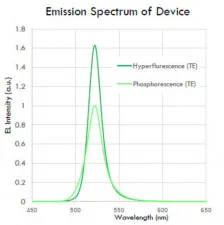The world moves faster than I write, so good stories pile up. Here are three OLED stories that have been sitting in the “Forthcoming DD” folder that sits in the upper left hand corner of my monitor.

Story #1
At the online OLEDs World Summit this fall, Kyulux CEO Nobuyuki Nakano said his company’s green hyperfluorescent material has met the efficiency, lifetime, and driving-voltage specifications required by OLED panel makers. More than that, said Nakano, the Kyulux material has better current efficiency, longer lifetime, and a narrower emission spectrum than the green phosphorescent emitters that are today’s standard (Fig. 1). “The company is currently planning for early commercialization of its materials by strengthening cooperation with panel makers,” a Kyulux statement said.
Kylux seems to have made significant progress, but we have heard optimistic “close to commercialization” statements before. So I won’t yell “touchdown” until I see a green hyperfluorescent emitter shining at me from a commercially available display.
 Fig. 1. Kyulux has announced that its new green hyperfluorescent OLED emitter has better current efficiency, longer lifetime, and a narrower emission spectrum than the green phosphorescent emitters that are today’s standard. (Figure: Kyulux)
Fig. 1. Kyulux has announced that its new green hyperfluorescent OLED emitter has better current efficiency, longer lifetime, and a narrower emission spectrum than the green phosphorescent emitters that are today’s standard. (Figure: Kyulux)
Story #2
Apple and Samsung Display have been pursuing a joint project to develop a 10.86″ OLED iPad. The tablet was originally scheduled to launch in 2022 and it would have been Apple’s first tablet to use an OLED display. But according to the Korean on-line news site The Elec, the partners have cancelled the project.
It seems that Samsung wanted to supply Apple with a larger version of its well proven RBG smartphone display. Apple, on the other hand, wanted a tandem design, which incorporates two emitting structures, one over another. The tandem structure would provide greater luminance and lifetime. Peak luminance is a chronic problem with OLEDs, and Apple wanted greater lifetime because it believes a tablet is used for more hours a day than is a smartphone.
Samsung currently makes only single-layer OLEDs. Developing a tandem design and the process and machinery for making it would be a significant investment, and it is likely the two companies could not agree on a price that simultaneously provided Samsung with an acceptable profit and Apple with its target selling price.
Story #3
We have reported previously that Samsung Visual Display intended to buy OLED panels from LG Display until Samsung Display Company’s QD-OLED panels were available in sufficient quantity. Here’s the update, again according to the The Elec. The newsite reports that Samsung has proposed that LG Display sell it two million WOLED panels for 2022 (in addition to four million TV-sized LCD panels).
It has been reported that Samsung will be showing its QD-OLED panels at CES in January. Will the theoretical benefits of QD-OLED be apparent to the average customer? And how will Samsung’s marketers distinguish between Samsung sets with the LG WOLED panels and those with Samsung’s own QD-OLED panels? How Samsung solves such problems is always interesting to watch. The company’s marketers have an impressive record of effectively differentiating their products, a challenge made easier because they have not allowed themselves to be overly limited by accepted industry terminology (as with “LED Display” and “QLED”). (KW)
Ken Werner is Principal of Nutmeg Consultants. He consults on display issues for attorneys, investment analysts, and companies using displays in their products. He is the 2017 recipient of the Society for Information Display’s Lewis and Beatrice Winner Award. You can reach him at [email protected].

